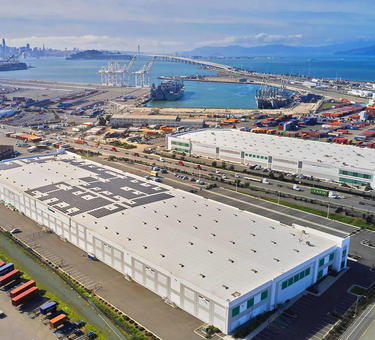
- U.S. logistics facilities still have excess capacity, limiting growth across the market. Despite rising this year, the IBI Utilization Rate remained below normal levels (85% to 86%) in Q3 (averaging 84.4%), reflecting spare capacity. With existing space to grow into, new logistics real estate demand was subdued in spite of healthy GDP and consumption growth.
- Average market rents declined by approximately 3% in Q3, led by declines in Southern California.i Prolonged decision-making timelines and sluggish demand are prompting some owners to increase concessions and lower headline rents on new leases, although trends vary widely by market.
- Vacancy is likely to remain near its cyclical peak through the first half of 2025 as occupier decision-making gradually picks up pace through 2025. Vacancies were at or near peak in Q3 at 6.8%. Improvement in demand will happen against a backdrop of falling new supply: Completions decreased 33% quarter-over-quarter in Q3 and will remain low through 2025.
The still-low IBI Utilization Rate signals that customers need to absorb excess space. Utilization began the year below 84%i and climbed through the year as supply chains replenished gradually. Excess capacity, built during COVID for resilience but now leveraged for cost control, has weakened the link between leading economic indicators and logistics real estate demand. Net absorption totaled 40 MSF this quarter, 34% down from normal levels.ii
Economic indicators reflected a resilient consumer. Robust retail goods sales and inventory replenishment boosted activity in operational logistics facilities. The IBI Activity Index, which has hovered around 60 since June, reflects the steady movement of goods through facilities, even as utilization and the inventory-to-sales ratio remained low by historical standards. Looking ahead, continued sales growth under a “soft landing” economic scenario will allow logistics real estate users to grow into excess space in 2025 and eventually restore the relationship between macro indicators and new demand for space.i
Rents in the U.S. declined by 3% in Q3. Southern California continued to pull down the U.S. average rent change. Its outsized volatility during the pandemic is manifesting in a prolonged recovery, despite limitations on new supply and the region’s crucial role in global supply chains. Elsewhere, rent growth patterns are not uniform: Markets like Houston, Atlanta and Nashville continued to record positive rent growth after a more stable cycle during the past few years. With replacement cost rents roughly 15% higher than current market rates, rent growth should accelerate in the medium term as a market vacancy recovery emerges.
At 6.8% in Q3 2024, vacancies are approaching peak. Completions decreased to 66 MSF in Q3 2024, down quarter-over-quarter 33% and down 49% from the peak of 129 MSF in Q3 2023. This contraction in new supply is likely to extend through 2025 as development starts fell by 20% year-to-date in 2024 compared to pre-pandemic levels. As a result, the pipeline of space under construction is at its lowest since 2017. ii
Conclusion
The logistics real estate market is progressing through a mini-cycle with subdued demand and vacancy likely to hover near cyclical peak as customers work through excess capacity and await greater certainty to make long-term supply chain decisions post-election. Under our base case “soft landing” scenario, a supportive macroeconomic backdrop and decreasing new supply should begin to restore demand-supply balance in 2025.i Prologis Research forecasts completions to decline by an estimated 30% year-over-year in 2025.i Market rent growth will return after vacancies move past peak, likely in the second half of 2025 and beyond. Taken together, this is an ideal time for logistics real estate occupiers to take advantage of a favorable part of the logistics real estate cycle.


